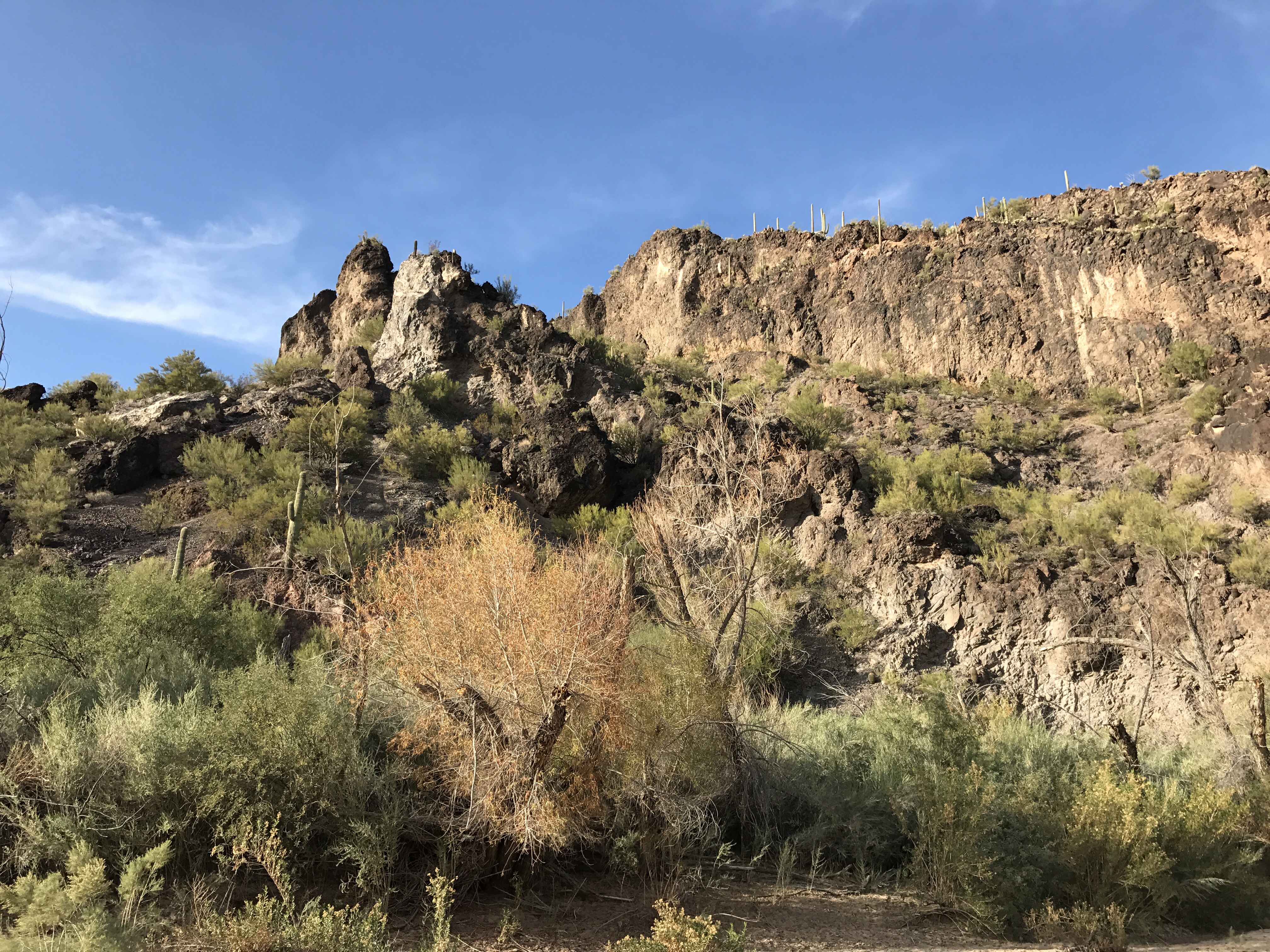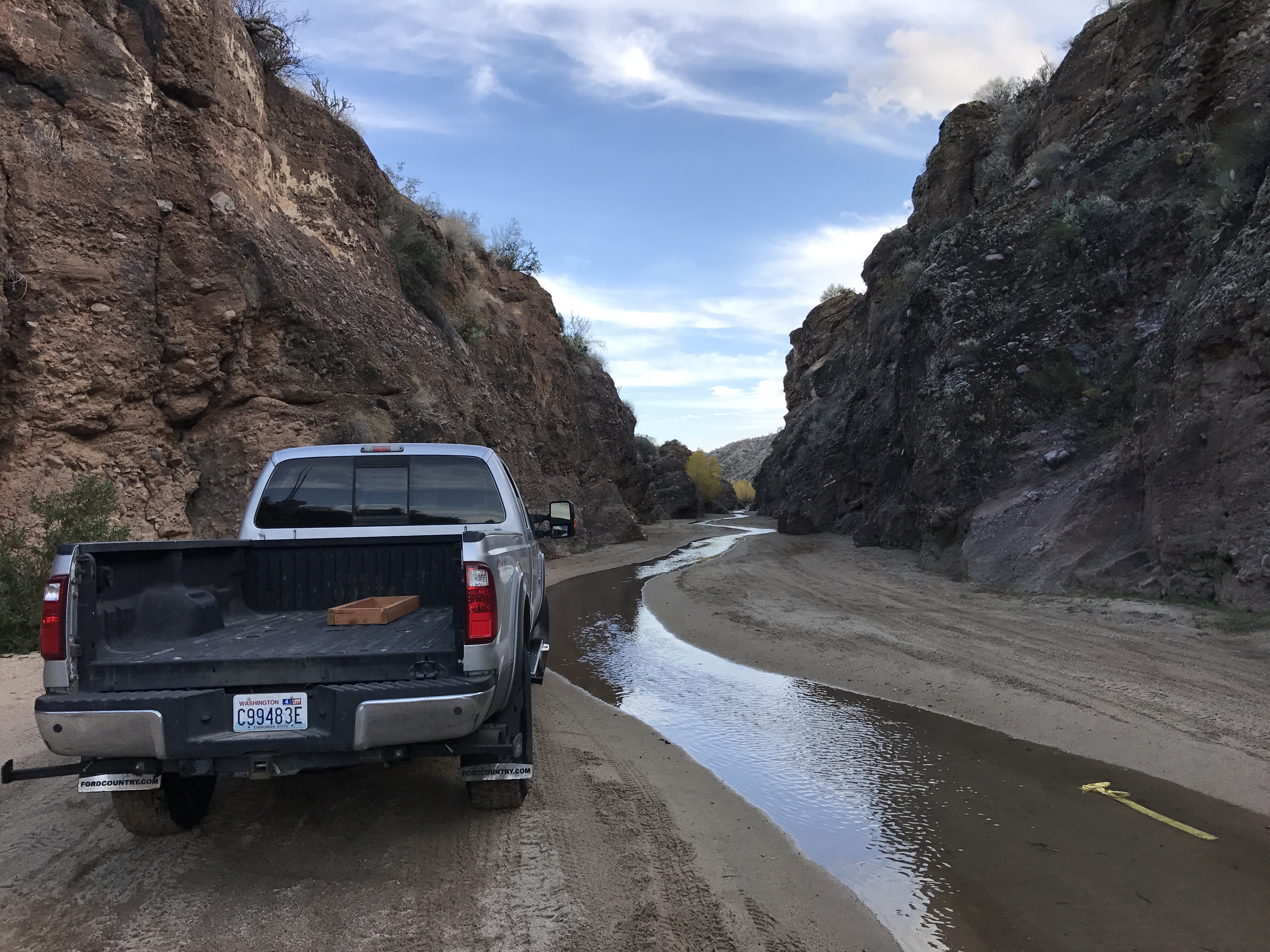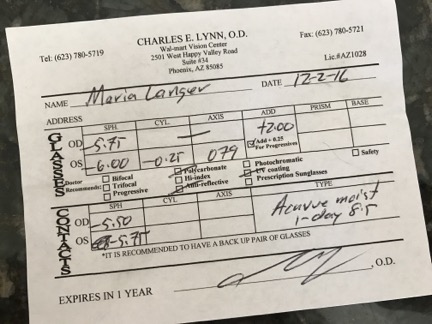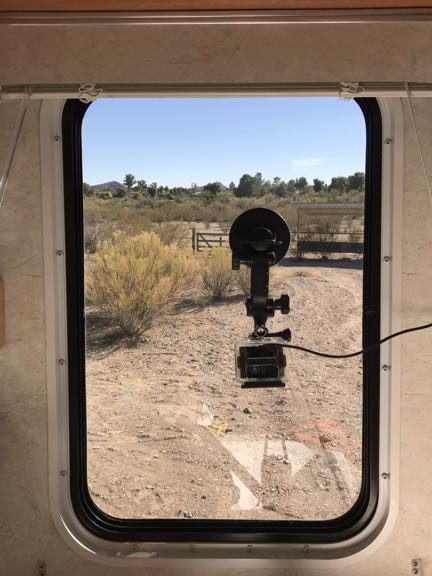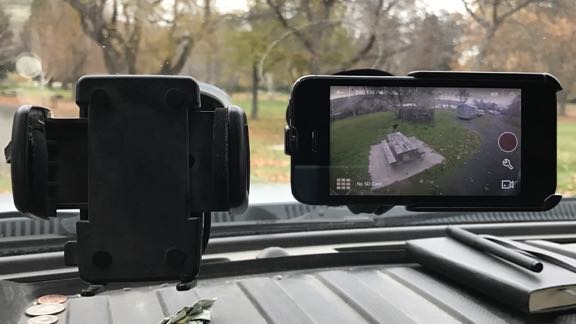The nuts and bolts of snowbirding with my new(ish) home away from home.

Here’s the Turtleback, parked on my truck in front of my RV garage. I usually stage it for a trip here, where I have easy access to water, power, and sewer connections.
Back in April of this year, I bought a 2005 Lance slide-in truck camper that I’ve dubbed the Turtleback. This was a huge step down in size from the fifth wheel I bought back in 2010, the Mobile Mansion, which I sold in September of this year. I wanted something more convenient to travel with and I got it. My 2012 Ford F350 SuperDuty Diesel carries the Turtleback like it’s nothing, making it easy to drive and park nearly anywhere I like. I tested it out on an overnight trip in the Leavenworth area not long after getting it and then again on a week-long foray in the North Cascades of Washington state and southern British Columbia. It’s the perfect rig for any spur-of-the moment trip; I can have it on the truck in about 30 minutes and put it away in my cavernous RV garage even quicker.
But how would it do on a very long trip? Like a 3-month trip?
That’s what I’m learning this snowbirding season. So far, so good. Although most of my traveling has involved overnight stops in a variety of locations ranging from a gravel side road overlooking a relatively remote Nevada lake to a partial-hookup campsite on the Columbia River, I’ve also parked it for two of more nights and disconnected it from my truck so I could drive while leaving it behind. My “postcards” that allude to this have generated a few questions and I thought I’d answer them here.
Hooking Up the Camper
Setting a slide-in truck camper atop a truck isn’t difficult to do, but it does require care and patience.
The most difficult part is getting the truck tailgate off. Due to the weight, I can’t do it by myself. I usually grab a visiting friend and enlist his or her help. First unplug the cable for the backup camera in the tailgate, then disconnect the cables that hold it up when it’s dropped, then angle it out of its pin hinges. I have a cart roughly the same height as the truck bed that I’ve covered with an old saddle blanket and we lay the tailgate on that. This makes it possible for me to move it around the garage without help. I use the same cart to store the hardware needed to secure the camper to the truck.
Sometime before putting the camper on, I visit the local Discount Tire shop and have them inspect the tires. They’re relatively new — I bought them last February while traveling and have been getting them rotated on schedule. I ask the guy to inflate them to the maximum pressure. We usually do 70 pounds for the front tires and 80 for the rear ones. Of course, I could do this at home — I have a good compressor in my shop — but I like the idea of having the tires looked at, especially before a long trip.
When I get home, I use my own compressor to inflate the air bags under the truck bed. There are two of them and I inflate each to about 50 pounds. This cranks up the back of the truck a bit, but the weight of the camper will bring it back to level once installed.
Next, I need to install the four support bars on the truck. They’re marked with their positions: passenger front, driver, rear, etc. They slip into slots I had installed on the truck and are secured in place with pins. This takes about five minutes. Once I put these on, they stay on until the camper is put away after a trip.
When I’m ready to put the camper on the truck, I begin by using a remote control to crank up the camper so that its bottom is higher than the truck bed. This utilizes the four camper “legs,” which have electric jacks on them. The control can raise or lower them all together or individually. Obviously, it’s a lot quicker to extend the legs (thus raising the camper) all at once, but I do have to be careful that all four legs are on the ground. Occasionally I’ll have to extend one a bit more by itself to keep them all grounded.
Then I slowly and carefully back the truck under the camper. The truck has to go straight back with the camper centered over the bed. There’s only about two inches of clearance on each side. I watch my progress through the back window — I have to put down the rear seat to see clearly. Sometimes I get out and check my progress; rushing is never a good idea. When I’m about 3/4 finished, I get out, climb on one of those support bars, and reach into the truck bed to plug in the camper’s power cable. This not only keeps the camper’s battery charged while I’m driving, but it also powers and controls the camper’s running lights and brake lights. Then I get back in the truck and back the rest of the way in.

Here’s the spacer, made with 2x4s, that the camper’s previous owner gave me when I bought it. It prevents the camper from damaging the taillight lenses.
Normally, you’d back up until the front of the camper bumps the lip of the truck bed right behind the cab. But because my truck has somewhat bulging taillights, if I backed up that far, the camper’s overhang would rub on my taillight lenses, scratching or breaking them. The previous owner’s truck was a 2013 Ford F350 nearly identical to mine. He’d taken short lengths of 2×4 lumber and had built a rectangle spacer that sits upright against the cab. He gave it to me when I bought the camper. So when I back up, the front of the camper bumps this 2×4 spacer, thus keeping the camper at least 2 inches back from where it would otherwise be. This makes it impossible for the camper to damage the taillight lenses.
Once the camper is in position, I shut down the truck, get out again, and use the remote to retract the camper’s legs. Little by little, the truck takes the full weight of the camper. The back end of the truck comes down. And then the legs of the camper start rising off the ground. I keep retracting them until they’re all within 4 inches from their stops. Again, sometimes this requires me to raise them individually. When I’m done, I can put the remote away in a little pocket I installed inside the camper door.
The last step is to use four spring-loaded screw tie-downs to attach the camper to the bars I installed earlier on the truck. This is the most time-consuming part because they always need to be adjusted. To adjust them, I use two 3/4 inch wrenches that I keep in a special bin with other tools related to the tie-downs in a compartment on the outside of the camper. I use the wrenches to loosen a bolt, then twist the spring up or down on the screw. When the screw’s length is long enough to keep the tie-down tight but not too tight, I tighten the bolt back up to keep it in place. I figure it takes me about 10 to 15 minutes to install all four tie-downs.

Here’s what the tie-downs on the driver’s side look like when installed. I leave the handle attached to the front driver’s side tie-down so it’s easy to disconnect when I refuel.
At this point, everything is done and I’m ready to roll. I figure that the active loading time (not including removing the tailgate or tending to the tire/airbag pressure) is about 30 minutes.
Prepping the Camper for Travel
Like any other RV, you need to prep the interior for travel. That means making sure all cabinets are securely latched, all loose items are secured, all windows and vents are closed, the antenna is cranked down, and the slide has been slid in. If there’s food in the fridge, I need to make sure it’s set to Auto mode so it automatically switches to propane when it’s not plugged in.
On the outside, I obviously need to make sure all water, sewer, and power is disconnected and all hoses and cables are stowed. Then I walk around and make sure all outside storage spaces are latched, the back door is securely closed, and the back step is up.
The last step is to tug on each of the tie-downs to make sure they’re still tight. As I drive, the camper shifts and one or more of the tie-downs can loosen up. That’s why I keep the wrenches handy. It takes about 5 minutes to adjust them before starting out for the day.
On the Road
The truck is definitely top heavy when I drive with the camper on board. I drive at the speed limit — never have to worry about getting a ticket! — and take curves and corners slowly.
I have to watch headspace. I’m not sure exactly how tall the rig is, but I figure 12 feet maximum to the top of the air conditioner. That means no drive-throughs or parking garages.
As for width, the rig is definitely wider than my truck, but its no wider than any other road-legal RV (8-1/2 feet). That means there’s no problems on any roads or going through any gates.
As for length, the camper adds about 2 feet to the back of my truck. That makes my already long truck even longer. Still, I can usually fit it in a parking space. This is a real joy when I make stops along the way for hikes or visiting other places of interest. With the Mobile Mansion, I was kept out of far too many places because I wouldn’t be able to fit in, park, or even turn around.

Want to go for a hike? No problem. My rig fits into trailhead parking spots, just like any other full-sized pickup.
And since the truck has high clearance and four wheel drive, I can drive it just about anywhere I like without worrying about getting stuck or bottoming out.
Another benefit of the setup is having easy access to my living space any time I’m stopped. Although it has a slide that must be closed in transit, I can still get into the camper to use any of its features while the slide is in. More than once, I’ve stopped for a hike or a rest and used the bathroom or made a meal in the kitchen. I recently reheated some leftovers in the microwave while at a scenic view area; prep the food on a plate, stick it in the microwave, push a button to start the onboard generator, run the microwave, turn off the generator, pull the plate out of the microwave. Can’t get any easier than that.
Overnight Parking
When I stop for the night, I can pull into a site any way I like. I usually park with the best view out the back. It easy enough to back up or park on any sort of angle in relation to a parking spot or campsite. (You can find a blog post about my “poor man’s backup camera” here.)

Two levels like this help me keep the camper level, whether it’s on the truck or on its own. This indicates the front end is high.

In this photo, I’ve used my leveling blocks to make a ramp that I’ve driven up to raise the driver’s side back wheel. I left it parked that way overnight.
My mail concern is getting the camper relatively level. This helps the refrigerator work more efficiently, but it also makes it more comfortable for my stay. No one likes to live in a space that’s slanted. If I can’t find a level spot to park on, I have Lego-like blocks I can use under one or more truck tires to help level it out.
If I’m parking for the night and plan to leave in the morning, I don’t need to offload the camper. I just shut off and lock the truck and move into the camper. Opening the slide is as easy as turning a key. If my overnight parking space has utility hookups, I can connect water, power, and even sewer with the camper still on the truck. If I don’t have a hookup, I can use battery power, propane, and the onboard generator (if needed) to operate the refrigerator, stove, water heater, furnace, etc. Only the microwave and air conditioner require more power than the batteries can provide; the generator can run either one. The camper holds 30 gallons of fresh water; a battery-powered pump delivers it to any faucet or the toilet. There’s even a solar panel on the roof to help keep the batteries fully charged during daylight hours.

Here’s my rig parked for the night in the desert near Wickenburg, AZ.
Off-Loading the Camper
If I plan to park for more than just one night, I’ll likely want to be able to drive the truck without the camper loaded. This means off-loading the camper. Again, this isn’t very difficult to do.
Once I’ve got it parked where I want it, I remove the tie-downs. In most cases, this means removing the securing pin and using a detachable handle to loosen it. I must remove them from the truck but can leave them dangling from the camper if I like. I usually completely remove them, however, and stow them in a safe place where they’ll stay clean and dry.
Then I use the remote to extend the legs so the camper is completely raised at least two inches off the truck. I get in the truck, pull forward a few feet, get out, unplug the camper’s power from the truck, get back in, and pull out the rest of the way. I must be completely clear of the camper.
Next, I use the remote to retract the legs so the camper is lowered back down. The lower it is, the more stable it is for moving around inside. The only thing I need to be careful of is the pipe for the generator’s muffler. Normally, I stop lowering when that’s at least a foot off the ground. I then consult the level indicators on the side and back of the camper and use the remote to raise or lower legs individually to get the camper level, again being careful to ensure that all four legs are solidly on the ground.

Here’s the camper and truck parked side by side at the KOA in Las Vegas. Note that I had a full hookup so I had all my hoses and 30 amp cable out. I’ve since bought a much shorter hose.

Here are the saw horses I bought at Home Depot. They collapse down into a small package and have handles to move them around.
If the camper will be parked for more than just a few days — as it is now and will be again at least a few times later in my travels — I help stabilize it by placing three collapsable saw horses under it. I bought these at Home Depot for about $50 each. Each one can (supposedly) support 1300 pounds. Since the camper (supposedly) weighs about 3500 pounds, I figure three should support it comfortably. The trick is to position them properly and adjust them to the proper height on ground that might not be level. Then I lower the camper onto them to the point where the sawhorses are taking about half the weight. All the legs are still within contact of the ground and (hopefully) supporting some of the weight. This prevents the camper from rocking when I move around inside, thus preventing damage to the legs. (I should mention here that I built a wheeled platform that performs the same function in my garage at home. That can actually take all of the camper’s weight.)

Here’s the camper on its sawhorses while parked in my friend’s backyard. It’ll be set up like this for at least two weeks and I’ll be in and out to clean and unpack/repack it. I have to confess that I lowered it onto one of the sawhorses before the others could share the weight and two of the sawhorse legs bent; I exchanged it for a new one at Home Depot yesterday and will be more careful in the future.
I figure that it takes about 15 minutes to offload the camper. Add about 10 minutes for the sawhorses, when used.
Why this Works for Me
As you can see, it’s pretty convenient for traveling. On the road, it’s like driving a big (but not huge) truck. When parked long term, it’s like living in a small trailer.
While towing a trailer might be easier for hooking up or unhooking when parked, having a pull trailer has two drawbacks. First, it isn’t as easy to get into tight parking lots or into campsites. Second, you can’t really tow something behind a pull trailer.
Although I’m not towing anything on this trip, I do have the ability to tow if I want to. I debated for months on whether I should bring my boat with me on this trip. In the end, I decided against it, mostly because I didn’t want the bother of having a difficult to park rig. But if I were going on a trip up to Roosevelt Lake or Lake Powell or anyplace else where it would be nice to have both an RV and a boat, I’m all set to do it. All I need is a tow bar extender, which is widely available online and in RV stores. My truck definitely has the power to pull it all.
So far, I’m very pleased with the way this has been working for me. But let’s see how I feel in three months after another 2,000 miles. I’ll have to report an update then.


